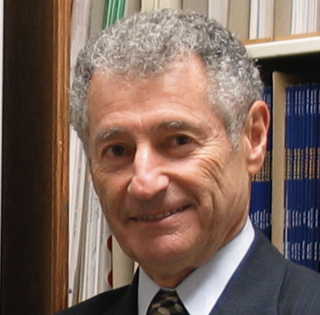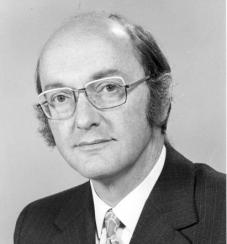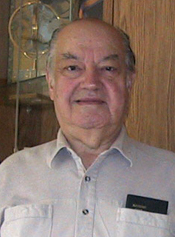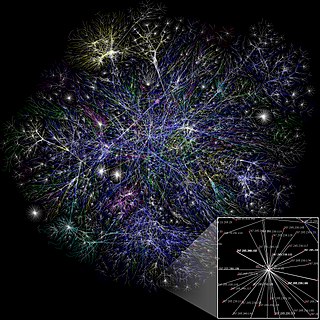In telecommunications, packet switching is a method of grouping data into short messages in fixed format, i.e. packets, that are transmitted over a digital network. Packets are made of a header and a payload. Data in the header is used by networking hardware to direct the packet to its destination, where the payload is extracted and used by an operating system, application software, or higher layer protocols. Packet switching is the primary basis for data communications in computer networks worldwide.

Queueing theory is the mathematical study of waiting lines, or queues. A queueing model is constructed so that queue lengths and waiting time can be predicted. Queueing theory is generally considered a branch of operations research because the results are often used when making business decisions about the resources needed to provide a service.

The Advanced Research Projects Agency Network (ARPANET) was the first wide-area packet-switched network with distributed control and one of the first computer networks to implement the TCP/IP protocol suite. Both technologies became the technical foundation of the Internet. The ARPANET was established by the Advanced Research Projects Agency of the United States Department of Defense.

A grande école is a specialized top-level educational institution in France and some other previous French colonies such as Morocco and Tunisia. Grandes écoles are part of an alternative educational system that operates alongside the mainstream French public university system, and take the shape of institutes dedicated to teaching, research and professional training in either pure natural and social sciences, or applied sciences such as engineering, architecture, business administration, or public policy and administration.

Leonard Kleinrock is an American computer scientist and Internet pioneer. He is Distinguished Professor Emeritus of Computer Science at UCLA's Henry Samueli School of Engineering and Applied Science. Kleinrock made several important contributions to the field of computer science, in particular to the mathematical foundations of data communication in computer networking. He has received numerous prestigious awards.

Donald Watts Davies, was a Welsh computer scientist and Internet pioneer who was employed at the UK National Physical Laboratory (NPL).

Paul Baran was an American-Jewish engineer who was a pioneer in the development of computer networks. He was one of the two independent inventors of packet switching, which is today the dominant basis for data communications in computer networks worldwide, and went on to start several companies and develop other technologies that are an essential part of modern digital communication.
Exponential backoff is an algorithm that uses feedback to multiplicatively decrease the rate of some process, in order to gradually find an acceptable rate. These algorithms find usage in a wide range of systems and processes, with radio networks and computer networks being particularly notable.

Larry Roberts was an American computer scientist and Internet pioneer.

The École Pour l'Informatique et les Techniques Avancées, more commonly known as EPITA, is a private French grande école specialized in the field of computer science and software engineering created in 1984 by Patrice Dumoucel. It is a private engineering school, member of IONIS Education Group since 1994, accredited by the Commission des titres d'ingénieur (CTI) to deliver the French Diplôme d'Ingénieur, and based at Le Kremlin-Bicêtre south of Paris.

A computer network is a set of computers sharing resources located on or provided by network nodes. Computers use common communication protocols over digital interconnections to communicate with each other. These interconnections are made up of telecommunication network technologies based on physically wired, optical, and wireless radio-frequency methods that may be arranged in a variety of network topologies.
In mathematics and computer science, optimal radix choice is the problem of choosing the base, or radix, that is best suited for representing numbers. Various proposals have been made to quantify the relative costs of using different radices in representing numbers, especially in computer systems. One formula is the number of digits needed to express it in that base, multiplied by the base. This expression also arises in questions regarding organizational structure, networking, and other fields.

The École Nationale Supérieure de Mécanique et d'Aérotechnique (ISAE-ENSMA) is a grande école founded in 1948 and located near Poitiers, France.
IEEE Internet Award is a Technical Field Award established by the IEEE in June 1999. The award is sponsored by Nokia Corporation. It may be presented annually to an individual or up to three recipients, for exceptional contributions to the advancement of Internet technology for network architecture, mobility and/or end-use applications. Awardees receive a bronze medal, certificate, and honorarium.

The University of Lorraine, abbreviated as UL, is a public research university based in Lorraine, Grand Est region, France. It was created on 1 January 2012, by the merger of Henri Poincaré University, Nancy 2 University, Paul Verlaine University – Metz and the National Polytechnic Institute of Lorraine (INPL). It aimed to unify the main colleges of the Lorraine region. The merger process started in 2009 with the creation of a Pôle de recherche et d'enseignement supérieur (PRES) and was completed in 2012.

The Paris Graduate School of Digital Innovation, formerly European Institute of Information Technology, is a private institution of higher education in computer science and software engineering that was founded in 1999.
Mohamed Ben Ahmed is a Tunisian educator. He is the founder, along with diplomat Habib Bourguiba, Jr., of the École nationale des sciences de l'informatique (ENSI), a school of information technology.

IMT Atlantique Bretagne Pays de la Loire is a technological university, which was created on January 1, 2017 through the merger of the École nationale supérieure des mines de Nantes and Télécom Bretagne. The engineering school is part of the Grandes Écoles, a prestigious group of French institutions dedicated to engineering, scientific research, and business education. It consists of three campuses: Brest, Nantes, Rennes. IMT Atlantique is a school of the Institut Mines-Télécom and a member of the Université Bretagne Loire.

Chiraz Latiri Cherif is a Tunisian academic, cultural researcher and politician. In 2006, she joined the staff of Manouba University where she specialized in cinema and multimedia. After heading the Tunisian Cinema and Image Centre (2017–2019), in February 2020 she was appointed Minister of Culture. That month, the Arab Cinema Center and The Hollywood Reporter honoured Latiri with the Arab Cinema Personality of The Year award.

















